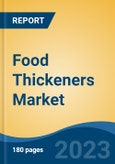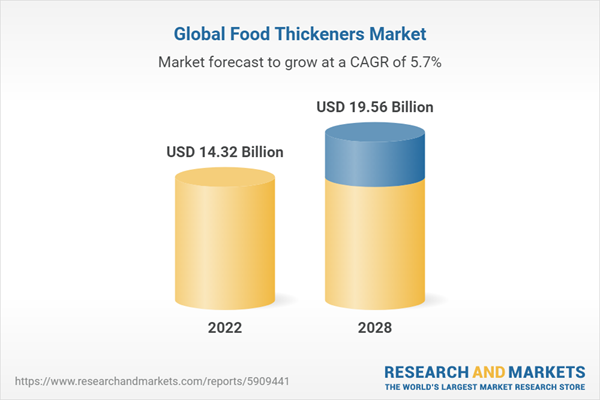Speak directly to the analyst to clarify any post sales queries you may have.
10% Free customizationThis report comes with 10% free customization, enabling you to add data that meets your specific business needs.
The increasing focus on health consciousness has led to a growing demand for plant-based and natural thickeners like agar, guar gum, and pectin, as consumers seek cleaner label products. Additionally, the aging population and the rise in cases of dysphagia, a condition characterized by difficulty in swallowing, have driven adoption in healthcare settings, contributing to market growth.
The Asia-Pacific region has emerged as a prominent player in the market due to changing lifestyles and a preference for convenience foods. Meanwhile, North America and Europe remain steady markets, driven by innovative food formulations and the prevalence of processed foods.
Despite this growth, the market faces several challenges, including raw material price volatility, regulatory constraints on synthetic thickeners, and the need for clear labeling to meet transparency standards. To address these challenges, manufacturers are investing in research and development to introduce novel, effective, and cost-efficient products that cater to various culinary demands and align with clean-label trends.
Key Market Drivers
1. Evolving Consumer Preferences and Dietary Trends: The global Food Thickeners market is primarily driven by changing consumer preferences and dietary trends. Consumers are increasingly seeking foods and beverages that offer both nutritional value and sensory satisfaction. Food thickeners play a crucial role in achieving the desired texture, consistency, and mouthfeel in various products, aligning with modern dietary requirements such as gluten-free, vegan, and allergen-free options.2. Aging Population and Health Conditions: The aging global population has led to a significant driver of the market, with the increasing prevalence of health conditions like dysphagia. People with dysphagia require modified diets with foods and beverages that have altered textures for safe consumption. Food thickeners are essential in achieving these modifications, driving demand in healthcare settings.
3. Expanding Food and Beverage Industry: The continuous expansion of the global food and beverage industry is another key driver. As the variety of food products available to consumers grows, there is a greater need for ingredients that enhance sensory attributes and overall product quality. Food thickeners play a critical role in achieving desired textures and consistencies, making products more appealing to consumers.
4. Technological Advancements and R&D: Ongoing technological advancements and research and development efforts by manufacturers are driving the market forward. Manufacturers are investing in innovation to create thickeners that are functional, easy to use, cost-effective, and versatile. This has led to the development of new and improved thickeners with enhanced stability and improved texture control.
Key Market Challenges
1. Raw Material Price Volatility: The market faces challenges due to the volatility of raw material prices. Many thickeners are derived from agricultural sources, and fluctuations in weather conditions and global supply chains can lead to inconsistent availability and increased costs of raw materials. Manufacturers need to diversify their sourcing strategies and implement effective risk management practices to mitigate price fluctuations.2. Regulatory Constraints and Clean Label Demands: Increasingly stringent regulations related to food safety, labeling, and ingredient transparency present challenges for manufacturers. Some synthetic thickeners may face limitations due to health and environmental concerns. The clean-label movement, driven by consumer demand for simple, recognizable ingredients, requires manufacturers to innovate in formulation and product development.
3. Labeling and Consumer Education: Clear and accurate labeling is essential, but complex ingredient names and potential effects can confuse consumers. Manufacturers must engage in effective consumer education initiatives to provide easily understandable information about thickeners' roles, benefits, and safety.
4. Technological and Formulation Complexities: The technical complexities of formulating products with thickeners can be challenging. Achieving the desired texture, consistency, and stability while maintaining flavor and nutritional value requires careful formulation and testing. Compatibility issues can arise when combining different thickeners or formulating with other ingredients.
Key Market Trends
1. Clean Label and Natural Ingredients: The demand for clean label and natural ingredients is a prominent trend. Consumers seek products with minimal processing and additives, driving manufacturers to use natural thickeners derived from plants and other natural sources.2. Plant-Based and Vegan Applications: The surge in plant-based and vegan lifestyles is driving the use of thickeners to create vegan-friendly products that mimic the textures of animal-derived ingredients.
3. Texture Innovation and Molecular Gastronomy: Texture innovation, influenced by molecular gastronomy, is a trend shaping the market. Chefs and food scientists are exploring new textures, driving the demand for thickeners that can create unique sensations.
4. Health and Functional Benefits: Consumers' interest in functional foods is driving the use of thickeners that offer health benefits beyond texture enhancement.
Segmental Insights
Type Insights: Starches are the most extensively employed food thickeners due to their versatile functionality, wide availability, and neutral flavor profile. They efficiently transform liquids into more viscous textures and are adaptable to various culinary applications.Application Insights: Sauces are the most embraced form of food thickeners, enhancing flavors and offering a pleasing mouthfeel in a wide range of dishes.
Regional Insights: North America is the fastest-growing segment, driven by shifting consumer preferences, healthcare requirements, and a dynamic food industry. The region showcases remarkable growth potential in the food thickeners market.
Report Scope:
In this report, the global Food Thickeners market has been segmented into the following categories, in addition to the industry trends which have also been detailed below:Food Thickeners Market, By Type:
- Protein
- Starch
- Hydrocolloids
- Others
Food Thickeners Market, By Source:
- Plant
- Animal
Food Thickeners Market, By Application:
- Bakery
- Confectionery
- Dairy & Frozen Desserts
- Sauces
- Convenience food
- Others
Food Thickeners Market, By Region:
- Asia-Pacific
- China
- Japan
- India
- Vietnam
- South Korea
- North America
- United States
- Canada
- Mexico
- Europe
- France
- United Kingdom
- Italy
- Germany
- Spain
- South America
- Brazil
- Argentina
- Colombia
- Middle East & Africa
- South Africa
- Saudi Arabia
- UAE
Competitive Landscape
Company Profiles: Detailed analysis of the major companies present in the global Food Thickeners market.Available Customizations:
Global Food Thickeners market report with the given market data, the publisher offers customizations according to a company's specific needs.This product will be delivered within 1-3 business days.
Table of Contents
Companies Mentioned
- Cargill, Inc.
- DuPont De Nemours, Inc.
- Kerry Inc.
- Guar Resources, LLC.
- Kent Precision Foods Group, Inc.
- TIC Gums, Inc.
- Naturex S.A.
- Medline Industries, Inc.
- Fooding Group Limited
- Emsland Group
Table Information
| Report Attribute | Details |
|---|---|
| No. of Pages | 180 |
| Published | November 2023 |
| Forecast Period | 2022 - 2028 |
| Estimated Market Value ( USD | $ 14.32 Billion |
| Forecasted Market Value ( USD | $ 19.56 Billion |
| Compound Annual Growth Rate | 5.7% |
| Regions Covered | Global |
| No. of Companies Mentioned | 10 |









